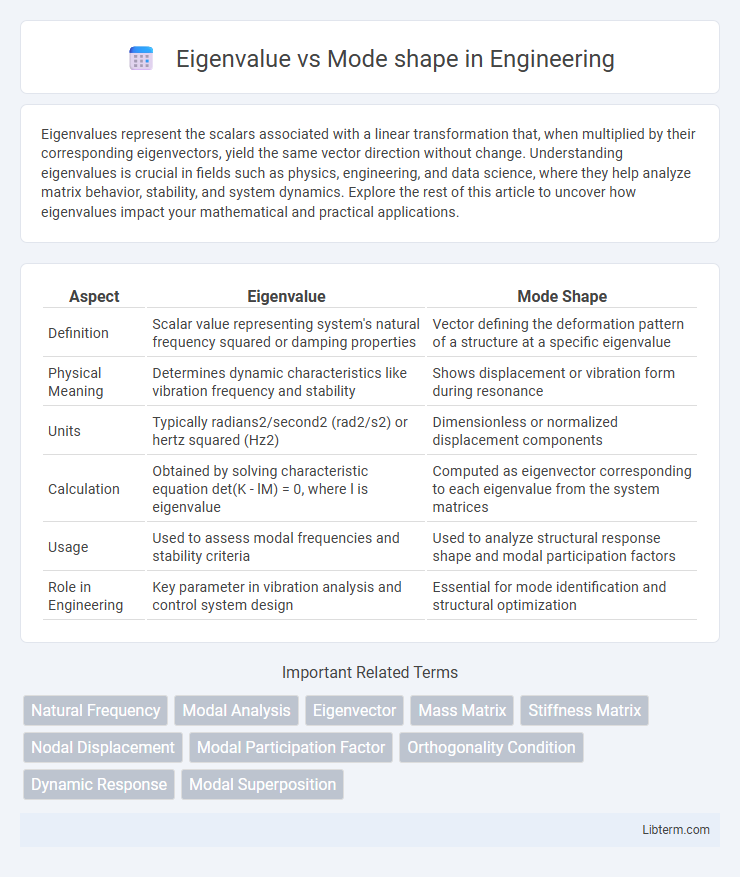Eigenvalues represent the scalars associated with a linear transformation that, when multiplied by their corresponding eigenvectors, yield the same vector direction without change. Understanding eigenvalues is crucial in fields such as physics, engineering, and data science, where they help analyze matrix behavior, stability, and system dynamics. Explore the rest of this article to uncover how eigenvalues impact your mathematical and practical applications.
Table of Comparison
| Aspect | Eigenvalue | Mode Shape |
|---|---|---|
| Definition | Scalar value representing system's natural frequency squared or damping properties | Vector defining the deformation pattern of a structure at a specific eigenvalue |
| Physical Meaning | Determines dynamic characteristics like vibration frequency and stability | Shows displacement or vibration form during resonance |
| Units | Typically radians2/second2 (rad2/s2) or hertz squared (Hz2) | Dimensionless or normalized displacement components |
| Calculation | Obtained by solving characteristic equation det(K - lM) = 0, where l is eigenvalue | Computed as eigenvector corresponding to each eigenvalue from the system matrices |
| Usage | Used to assess modal frequencies and stability criteria | Used to analyze structural response shape and modal participation factors |
| Role in Engineering | Key parameter in vibration analysis and control system design | Essential for mode identification and structural optimization |
Introduction to Eigenvalues and Mode Shapes
Eigenvalues represent specific scalar values that characterize the natural frequencies of a system, while mode shapes define the corresponding deformation patterns during vibration. In structural dynamics, each eigenvalue corresponds to a natural frequency where the system oscillates without external force, and the associated mode shape illustrates the displacement configuration at that frequency. Understanding the relationship between eigenvalues and mode shapes is essential for analyzing stability and predicting dynamic behavior in mechanical and civil engineering structures.
Fundamental Concepts of Eigenvalues
Eigenvalues represent scalar values indicating the magnitude of a system's characteristic response, crucial for stability and dynamic analysis. Mode shapes correspond to the specific deformation patterns or vibration modes associated with each eigenvalue in a structural or mechanical system. Understanding fundamental concepts of eigenvalues enables accurate prediction of natural frequencies and behavior under dynamic loading conditions.
Understanding Mode Shapes in Structures
Mode shapes represent the specific deformation patterns that a structure undergoes at distinct natural frequencies, or eigenvalues, during vibration. Each eigenvalue corresponds to a unique mode shape, describing the relative displacement of elements within the structure under dynamic loading. Understanding mode shapes is crucial for predicting structural responses and designing for dynamic stability and resilience against forces such as earthquakes and wind.
Mathematical Relationship Between Eigenvalues and Mode Shapes
Eigenvalues represent the squared natural frequencies of a system, derived from solving the characteristic equation of the dynamic matrix, while mode shapes correspond to the eigenvectors associated with each eigenvalue, defining the specific deformation patterns during vibration. The mathematical relationship is captured by the generalized eigenvalue problem [K - lM]ph = 0, where K is the stiffness matrix, M is the mass matrix, l denotes the eigenvalue, and ph is the mode shape vector. Each eigenvalue l provides a scalar that scales the mode shape ph, illustrating how structural vibrations are governed by the simultaneous solution of these eigenvalues and eigenvectors.
Physical Significance of Eigenvalues
Eigenvalues represent the natural frequencies at which a structure tends to vibrate, reflecting its inherent stiffness and mass distribution. These scalar quantities indicate the energy levels where resonance occurs, directly impacting the dynamic stability and response of mechanical systems. Unlike mode shapes, which describe the deformation patterns during vibration, eigenvalues provide critical insights into the system's potential for oscillatory behavior and are essential for predicting failure modes and designing vibration control strategies.
Practical Interpretation of Mode Shapes
Mode shapes represent the specific deformation patterns of a structure at particular natural frequencies, illustrating how different parts of the system move relative to each other during vibration. Eigenvalues correspond to the squares of these natural frequencies, indicating the energy levels associated with each mode shape. Understanding mode shapes aids engineers in identifying critical points of maximum displacement and stress, facilitating targeted design improvements and vibration control strategies.
Key Differences: Eigenvalues vs Mode Shapes
Eigenvalues represent the natural frequencies at which a system vibrates, quantified as scalar values indicating the stiffness-to-mass ratio. Mode shapes describe the deformation patterns of the system at specific eigenvalues, represented as vectors showing relative displacements of each point. The key difference lies in eigenvalues defining vibrational frequencies while mode shapes illustrate the corresponding geometrical deformation during resonance.
Applications in Engineering and Physics
Eigenvalues determine the natural frequencies at which structures or physical systems resonate, while mode shapes describe the corresponding deformation patterns during vibration. In engineering, eigenvalue analysis is crucial for designing stable buildings, bridges, and mechanical components by predicting potential resonance failures. Physics applications include quantum mechanics and wave propagation, where eigenvalues represent energy levels and mode shapes illustrate wavefunction configurations.
Computational Methods for Eigenvalue and Mode Shape Analysis
Computational methods for eigenvalue and mode shape analysis primarily involve solving the characteristic equation derived from a system's stiffness and mass matrices using techniques like the Finite Element Method (FEM). Eigenvalues represent natural frequencies indicating system stability, while corresponding mode shapes depict deformation patterns at those frequencies. Efficient algorithms such as the Lanczos method and subspace iteration enhance accuracy and computational speed in determining large-scale structural dynamics properties.
Summary: Choosing the Right Approach for Analysis
Eigenvalue analysis identifies natural frequencies of a system, essential for predicting resonance and stability. Mode shape analysis reveals the deformation patterns associated with each frequency, helping to understand system behavior under dynamic loading. Selecting the appropriate method depends on whether the goal is frequency characterization or detailed spatial response evaluation in structural dynamics.
Eigenvalue Infographic

 libterm.com
libterm.com